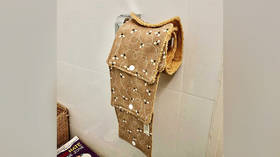Is reusable toilet paper the answer to Covid-19 loo roll panic buying? After testing it, I hope not

It’s being billed as the answer to all our needs in these coronavirus-induced stockpiling times that we now inhabit. But of all of the portents of doom, surely none is as deeply alarming as the emergence of reusable toilet paper.
While it might sound like a product fit to sit alongside paper umbrellas and helicopter ejector seats, “washable/reusable toilet non-paper!” – as its creators at Handmade Australian Textiles dub it – is not only real, but zeitgeisty. What could be more environmentally friendly than, essentially, the grown-up equivalent of a traditional nappy?
As fever-brained shoppers wrestle over rolls of toilet tissue in supermarkets, a small and strong-stomached number of consumers have been handing over AUS $48 (£24) for a scroll of 20 squares of jauntily printed material with either a terry-towelling or microfibre backing.
So amid the frenzied worldwide rush for disposable rolls (we each use 57 sheets a day, apparently), I was chosen to be RT.com’s representative – thanks, guys – to trial the reusable variety. It’s a crappy job, but someone’s gotta do it. Always here to get to the bottom of what’s best for you, dear reader.
How bad could it be? After all, humans had lived without toilet paper for hundreds of years before the Chinese invented the disposable kind in the 14th century. Romans apparently employed a sponge on a stick, Eskimos used moss, the Greeks preferred clay and Native Americans utilised corn cobs. Anything splinter-free seemed good to me; my task, comparatively, should have been a breeze.
Demand for this new reusable product meant we were not lucky enough to have our choice of the “gorgeous” decorative designs (though we did opt for the optional plastic press studs, which allow you to form the world’s thinnest door snake). What we ended up with was jaunty buzzing bees on our backing, which seems a slightly strange choice for something you’re going to rub on your nether parts (perhaps it’s an oblique Winnie-the-Pooh reference, or ‘Bees means Hinds’?).
The arrival of the non-paper in our house caused a degree of shock and horror, with my children and wife recoiling as if I were waving an actual hive in their faces. There was much appalled pondering about how awful it would be if visitors mistook the squares for hand towels. Or, heaven forfend, face cloths.
Forced to go it alone, I must admit it took me some time to gird my loins – and hands – for the task. It was not just that I was put off by the general icky-ness, but I was also concerned about how best to navigate the plastic studs; things could go painfully wrong with one false manoeuvre.
But, as Alex Ferguson might say, it was squeaky-bum time. Having finally manned up and put my back(side) into it, I can tell you that the experience is very much like being in a friend’s bathroom, finding there’s no toilet paper, and concluding that the only option is to wipe your butt with one of their towels. Not much of a choice, really.
Is it unpleasant? Physically, no, but mentally it is about as disturbing as washing your face with sandpaper. And then there’s the question of what to do with the soiled squares, which go from pretty to s**tty faster than a two-year-old girl switching to tantrum mode.
Eventually, based on my experience of Asian toilets, I set up a tiny bin for my waste non-paper, but then my concerns turned to how I would ever get the little squares clean again once used. I decided to consult the product’s creator, and entrepreneur in the making, 26-year-old Australian Eloise Marsh.
“I’d been thinking of doing reusable toilet paper for a while, because I was already selling a reusable non-paper towel,” she explained, until I interjected with an “I’m sorry, but isn’t that just called a towel?”. “But,” she continued unfazed, “I wasn’t sure there’d be a market for it, and then the toilet-paper crisis hit, so I went for it, and now it’s going crazy. One woman bought seven rolls off me.”
And then things got a little awkward, as Ms Marsh admitted that she’d never actually used her own product for number twos, only number ones (not an option that occurred to me, as a man). Oh, and she’d forgotten to send me the accompanying Care Sheet, which would have explained that I needed to rinse my squares, and possibly my backside (it wasn’t clear), immediately after wiping.
Indeed, she sounded mildly disturbed by my careless disposal, pointed out that “most people use it with a bidet”, and then gave a low whistle and a “wow, your wife’s going to be annoyed at you - good luck getting it clean”.
Ms Marsh was also slightly vague about her claims that the softer option she offers is more environmentally friendly than flushing tonnes of paper down the loo over your lifetime. Even taking into account the water-heavy practices of cotton farming, and the colours and dyes used in her work, she believes that “if you use my product until the end of its life, it should be more environmentally friendly in the long run, and cheaper, too”.
So what exactly would the life of a roll of used reusable non-paper be? Having read through the comments on Handmade Australian Textiles’ Facebook page, I came across a clue in one succinct point: would I actually be able to put these in the washing machine and not get divorced? I can only tell you that, in my experience, the answers are almost certainly: vanishingly short, and no. So long as my local supermarket hasn’t run out of disposable rolls, that is.
Have you tried the new eco-friendly reusable toilet paper? pic.twitter.com/lqpJlCIV8I
— Tech-FAQ (@tech_faq) March 13, 2020
The statements, views and opinions expressed in this column are solely those of the author and do not necessarily represent those of RT.













